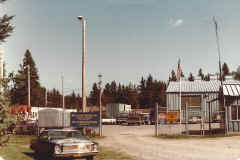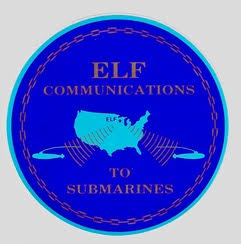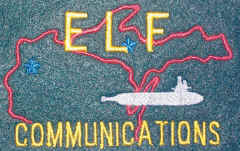USN ELF Communications System
Early ELF tests -
There were two feasibility tests in the 1960's. Many thanks to Don Utt
for info, pointers, and corrections.
- Tests in Wyoming used a 70 km long stretch of HV power line that was
disconnected at night.
- Tests in NC/VA (Test Site Alpha) conducted by RCA Laboratories as part of
Project Pangloss used a 176 km long line constructed from Lookout Shoals NC
to Algoma VA. The line resembled a 3-phase power line with the 4/0
(0.46" dia.) lines hooked
together and grounded at the ends. The transmitter (10kw or 120kw vibration table
amp) was initially housed in a
mobile van and later in a building (Ararat NC?).
- The North ground system consisted of a 2000 sq. ft. mesh with ground rods.
The South ground system consisted of nine 1200 ft. radials in the lake. source.
Another article says the early tests had ground radials several kilometers
long at each end.
- Another source
says "The concept of a horizontal grounded wire was tested in 1962 by
the DECO company with a leased power line 70 kilometers long [in Wyoming]
and, in 1963,
during the "intensive test" phase, with a purpose-built wire
aerial running 176 kilometers between West Virginia [sic] and North
Carolina. The current in the antenna was 60 amps and various ELF frequencies
between 4 Hz and 500 Hz were radiated. Accurate data of atmospheric
attenuation were obtained and, for the first time, the submarine USS Seawolf
detected ELF signals 3200 kilometers away in the North Atlantic. This was in
early 1963 [April?] at a radiated power of one watt." This info
was probably taken from this article.
- A 1963
Polaris project report says "Once set up, we ran something that
could be regarded as a decisive experiment and figure
30 indicates the results at 520 miles with the submarine moving at 6
knots at a 150-foot depth. Again, we received a 156-cycle
signal at 2500 miles with the submarine moving at 18 knots at a
150-foot depth."
- Another source
says "Extremely low frequency (ELF) electromagnetic wave propagation
was investigated by measuring the amplitude of a CW signal transmitted from
the Sanguine site in North Carolina to receiving sites located in New York
State, Labrador, and Iceland. The attenuation factor α and the
reciprocal of the excitation factor were determined. Data for daytime,
nighttime, and sunrise transition paths were obtained. The attenuation
factors obtained for 78 and 156 Hz are compared with the value of α
obtained from measurements of atmospherics. The attenuation values at 78 Hz
of 1.29 and 1.01 dB/1000 km, and a value of 0.75 dB/1000 km at 45 Hz,
obtained by interpolation of results of this and other experiments, were
used in Sanguine systems analysis."
- 1981
New York Times story "How huge antenna can broadcast into the
silence of the sea"
- Roland J. Starkey, Jr., "The Renaissance in Submarine
Communications, Part III, The ELF Odyssey 1958-1979,"
Military Electronics/Countermeasures,
January 1981, p. 26. pdf
- A report I'd like to find is C. A. Martin, "Site Evaluation for a
Beverage Type Transmitting Antenna", PANGLOSS Task 4 Technical Note 6,
RCA Laboratories, Princeton, NJ, 1964.
- Another report I'd like to find is the "Propagation Measurements
Along a 4900 km Path", Project Sanguine Special Topics Report 11, RCA
Labs, Princeton NJ, 1967. - This article
probably has the same info.
- If you have any technical or other info on these early tests, please let
me know.
NC ELF experiment
 |
 |
-- |
-- |
Clam Lake WI - Naval Electronic Engineering Office
|
 |
 |
 |
 |
 |
 |
 |
 |
From Naval Facilities Engineering Command History 1965-74, Chapter 10 - link
SANGUINE/SEAFARER
An important communications development during the period under consideration
was extremely low frequency radio (ELF). Extremely low frequency radio utilizes
forty-five to seventy-five hertz waves which can be detected almost everywhere
on the earth and to a considerable depth at sea. The Navy began research and
development on extremely low frequency broadcasting in 1960. The problem with
this type of broadcasting was that a gigantic antenna was required. Such an
antenna would represent a prodigious construction feat. The Naval Facilities
Engineering Command would naturally be responsible for such construction. The
code-name for the Navy's extremely low frequency broadcasting project was
"Sanguine." Sanguine was to consist of a "hardened" grid
antenna system approximately forty to eighty miles square. The antenna would be
buried and the transmitter stations (one at each intersection in the grid) would
also be subsurface so that they could withstand attack. Such an installation
would allow the broadcasting of virtually unjammable radio waves, each about
2,500 miles long. These would fill the space between the ionosphere and the
earth's surface and would penetrate sea water to a considerable depth. Deep
running submarines trailing special receiving antennas could be in constant
communication with their headquarters thus long-range strategic weapons would be
even more finely controlled. Because of the low conductivity of their soils,
central Texas and northern Michigan have been tentatively selected as sites for
one or more of the antenna complexes.(22l)
Thus far the Naval Facilities Engineering Command's major involvement in this
project has been in the area of data collection for site selection. The Command
built a test facility in Wisconsin to determine whether the system would work
and whether the system would adversely affect the environment. The test site
consisted of two antennas, each twenty-five miles long in the form of a cross. A
transmitter building was constructed at their intersection.(222) Operations at
the test site proved that the system would indeed function as planned and that
it had no significant adverse affect on the environment.(223)
During fiscal year 1975, project Sanguine took a new direction. It was
decided not to harden the transmitting facilities, but to build them on the
surface. Only the antenna itself would be buried. Because of this change,
Sanguine's name was changed to "Seafarer." Building the transmitter
stations on the surface would mean a substantial reduction in the total cost of
the project, bringing it down to an estimated $200 million. Of this sum, $46
million was programmed for the fiscal year 1978 Military Construction Program.
221 Luzum and Jackson interview.
222 Ibid.
223 Ibid.














